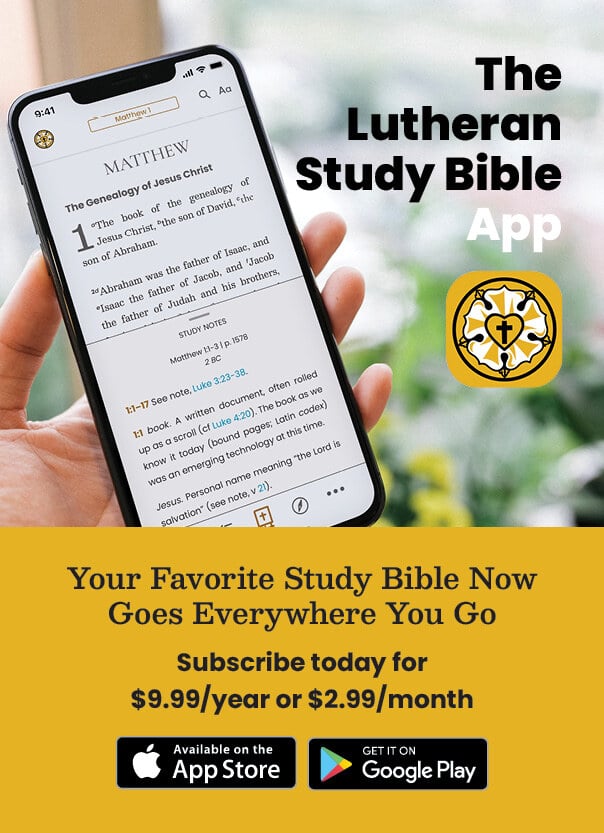Simple Family Devotions with Lutheran Service Book
We have a great bedtime routine in our family, although I’m not sure where it came from. After dinner, we clean up the toys. The kids use the potty and hear a story. They brush their teeth and put on their pajamas. There’s usually a few minutes of sprinting up and down the hallway, and then we sit down for a devotion before laying everyone down.
History of the Hymn of the Day
Each Sunday, the regular rhythm of worship includes singing the Hymn of the Day. It helps guide you and other Christians through our beautiful Church Year in song. Do you know how the Hymn of the Day came to be part of our worship services? Read an excerpt from Lutheran Service Book: Companion to the Services to learn how Martin Luther saw value in having this and how Lutherans encouraged the practice through robust hymn writing.
Lutheran Service Book: Hymn Devotions throughout the Church Year
There’s a rich history to all of the hymns in Lutheran Service Book. This history easily lends itself to beautiful devotional materials that blend seamlessly into the Church Year. Read these excerpts from five different hymns spanning the entire Church Year from Lutheran Service Book: Devotional Edition to see how this fantastic book can bring you deep, meaningful devotions.
Five Well-Loved Hymns by Paul Gerhardt
Paul Gerhardt (1607–76) is considered to be a prolific composer, writing 123 hymns during his lifetime that are still enjoyed by the church today. His dedication to hymn writing even during times of war and suffering showcase how Christ's love can be a rock of comfort no matter what. Read about his top five hymns below to see insights on both the hymn texts and history surrounding each one.
Organ Music for Every Hymn of the Day
One staple of worship every Sunday is the Hymn of the Day. Whether printed in your bulletin or posted on the hymn outline board at the front of the church, the Hymn of the Day connects to the theme of the worship service. These hymns become a staple of the service as they’re repeated every one or three years, depending on your preferred lectionary. They help your congregation members familiarize themselves with the hymnal and connect similar themes across church seasons.
Teaching Kids to Sing with Canons from One and All Rejoice
One and All Rejoice (OAR) contains numerous opportunities for teaching children part singing. A great way to get started is by learning one of the many canons included in OAR. To discover everything that can be sung in canon in OAR, check out the index “Hymns and Songs in Canon” on page 361 of the hymnal.
5 Hymns to Sing in Honor of the 500th Anniversary of the First Lutheran Hymnal
In 1523, Martin Luther wrote to Georg Spalatin (1484–1545), private secretary to Elector Frederick III (“the Wise”) of Saxony. With his superb humanist education, Spalatin was sought by Luther as one skilled in the German language and capable of writing German hymns based on psalms. Thus, by 1523—a mere six years after the posting of the Ninety-Five Theses—Luther was committed to providing German-language hymns for the people to sing and was actively seeking gifted poets to work with him on this project. This work led to the publication of the first Lutheran hymnals in 1524 for which we now mark the five hundredth anniversary.
The Life and Legacy of Isaac Watts
[Historically, in church music] Lutherans sang hymns from the beginnings of the Reformation. Calvinists, though, in their zeal to use nothing but the Bible in worship, tended to restrict their singing to biblical psalms. Though they might have chanted them—a musical style that makes possible the singing of prose just as it is written without alteration, straight from the Bible—instead they made metrical translations, complete with regular rhythms and rhymes. In practice, these metrical psalms were closer in some ways to vernacular hymns than to the text of the Bible. Such psalm singing is still the practice in some conservative Reformed churches today, and it was the norm for early English Protestantism. Then came Isaac Watts
Noteworthy People in Church Music: Johann Walter
There are numerous historical figures who gave their gifts to Lutheranism and hymnody as a whole. Their contributions to Christianity give us amazing ways to praise God and all that He has given us. One who stands out is Johann Walter, who published the first collection of Lutheran choral music. Read more about his work with Martin Luther, hymn publication, and three hymns that appeared in his book of choral music with an excerpt from Lutheran Service Book: Companion to the Hymns below.
Celebrating the 500th Anniversary of the First Lutheran Hymnal
Beloved Lutheran hymnals have a long history, dating all the way back to 1524 in Germany. Each variation has been used for different purposes, such as a home devotional that eventually led to a worship hymnal. Learn more about the beauty of Lutheran hymnals from the very first edition to Lutheran Service Book today with this excerpt from Lutheran Service Book: Companion to the Hymns.




















